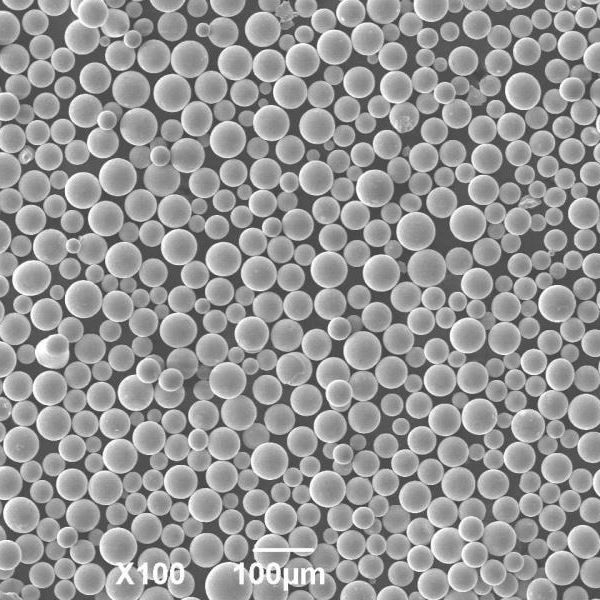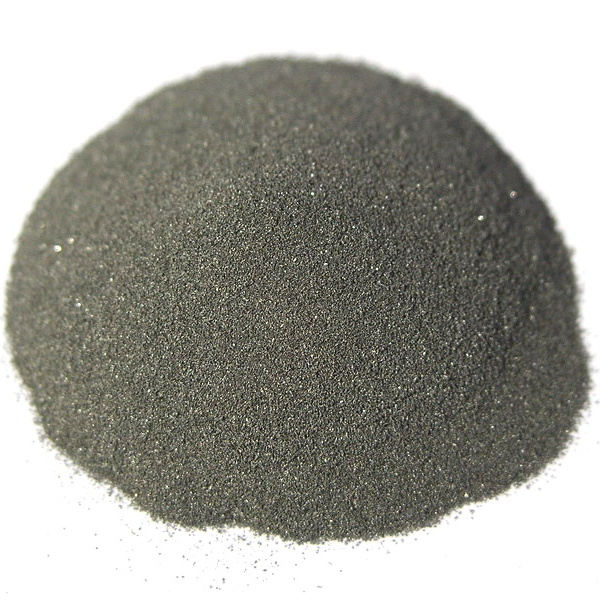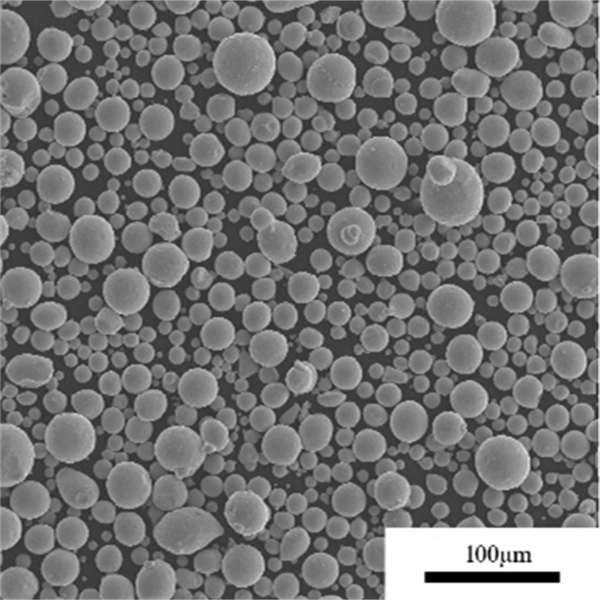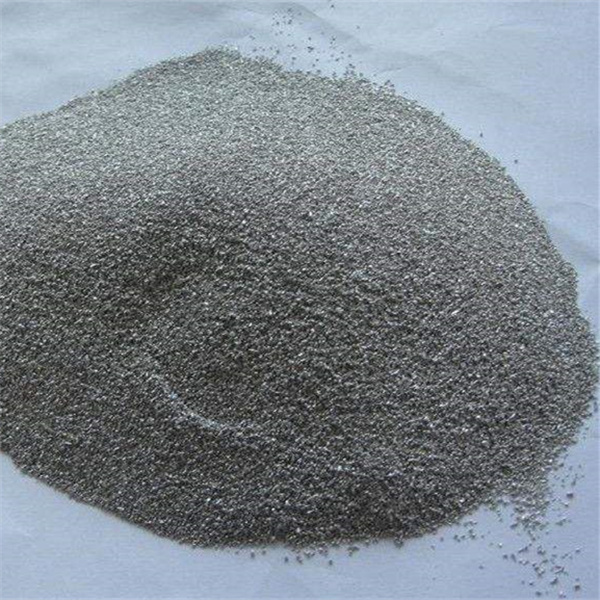GH4169 Powder
GH4169 powder is a precipitation hardening stainless steel powder designed to provide high strength, hardness and corrosion resistance after heat treatment. It contains 17% chromium along with nickel, aluminum, titanium, and niobium additions for enhanced mechanical and corrosion properties.
Low MOQ
Provide low minimum order quantity to meet different needs.
OEM & ODM
Provide customized products and design services to meet unique customer needs.
Adequate Stock
Ensure fast order processing and provide reliable and efficient service.
Customer Satisfaction
Provide high quality products with customer satisfaction at the core.
share this product
Table of Contents
GH4169 powder is a precipitation hardening stainless steel powder designed to provide high strength, hardness and corrosion resistance after heat treatment. It contains 17% chromium along with nickel, aluminum, titanium, and niobium additions for enhanced mechanical and corrosion properties.
| Size Range | 15-45um/15-53um/20-63 um | 45-105um |
| Form | Spherical | Spherical |
| Flow Ability | ≤25s | |
| Apparent Density | ≥4.0 g/c㎡ | |
| Oxygen Content | ≤200 ppm | |
| Nitrogen Content | ≤150ppm | |
Key characteristics of GH4169 powder:
GH4169 Powder Properties
| Properties | Details |
|---|---|
| Composition | Fe-17Cr-4Ni-1.5Ti-0.7Al-0.25Nb alloy |
| Density | 7.9 g/cc |
| Particle shape | Irregular, angular |
| Size range | 10-150 microns |
| Apparent density | Up to 50% of true density |
| Flowability | Moderate |
| Strength | Very high after aging treatment |
| Corrosion resistance | Excellent, including marine environments |
GH4169’s exceptional strength-to-weight ratio combined with outstanding corrosion resistance make it suitable for critical structural parts across aerospace, marine, nuclear and other demanding applications.
GH4169 Powder Composition
Typical composition of GH4169 precipitation hardening stainless steel:
GH4169 Powder Composition
| Element | Weight % |
|---|---|
| Iron (Fe) | Balance |
| Chromium (Cr) | 16-18% |
| Nickel (Ni) | 3.5-5.5% |
| Titanium (Ti) | 1.2-1.8% |
| Aluminum (Al) | 0.3-1.2% |
| Niobium (Nb) | 0.15-0.45% |
| Carbon (C) | 0.04% max |
| Silicon (Si), Manganese (Mn) | 1% max each |
- Iron provides the ferritic matrix
- Chromium improves corrosion and oxidation resistance
- Nickel, aluminum, titanium and niobium facilitate precipitation hardening
- Carbon and other elements limited as tramp impurities
The composition is designed to maximize the precipitation hardening response and corrosion resistance required in structural applications.
GH4169 Powder Physical Properties
GH4169 Powder Physical Properties
| Property | Values |
|---|---|
| Density | 7.9 g/cc |
| Melting point | 1400-1450°C |
| Electrical resistivity | 0.80 μΩ-m |
| Thermal conductivity | 12 W/mK |
| Thermal expansion | 12 x 10^-6 /K |
| Maximum service temperature | 650°C |
- High strength-to-weight ratio
- Retains strength and hardness up to 650°C
- Relatively low thermal conductivity
- Resistivity increases after precipitation hardening
- Moderate expansion coefficient
The properties allow use of GH4169 in load bearing structural applications requiring corrosion resistance and high temperature strength.
GH4169 Powder Mechanical Properties
GH4169 Powder Mechanical Properties
| Property | Condition | Values |
|---|---|---|
| Hardness | Solution annealed | 90 HRB |
| Hardness | Peak aged | 40-45 HRC |
| Tensile strength | Annealed | 550-750 MPa |
| Tensile strength | Peak aged | 1300-1600 MPa |
| Yield strength | Peak aged | 1100-1400 MPa |
| Elongation | Peak aged | 8-13% |
- Ages to high strength levels exceeding other precipitation hardening stainless steels
- Retains good ductility in peak aged condition
- Significant increase in hardness after aging treatment
- Strength can be tailored through aging time and temperature
These properties make GH4169 suitable for lightweight, high strength structural parts needing corrosion resistance.
GH4169 Powder Applications
Typical applications for GH4169 precipitation hardening stainless steel powder include:
GH4169 Powder Applications
| Industry | Example Uses |
|---|---|
| Aerospace | Airframe and engine components, fasteners |
| Marine | Shafts, fixtures, solenoids, valves |
| Nuclear | Fuel element cladding, internal structures |
| Oil and gas | Structural parts for wellheads, offshore platforms |
| Chemical | Process equipment like vessels and pipes |
Some specific uses:
- Bolts, nuts, screws, and studs needing high strength
- Critical rotating shaft components
- Valve and pump bodies used in corrosive environments
- Mixing equipment like impellers and agitators
- Nuclear fuel element cladding and vessel internals
GH4169 provides an exceptional combination of strength, hardness and corrosion resistance required in critical structural parts across demanding industries.
GH4169 Powder Specifications
Key specifications for GH4169 powder include:
GH4169 Powder Standards
| Standard | Description |
|---|---|
| AMS 5922 | Precipitation hardening stainless steel powder for aerospace parts |
| ASTM A580 | Standard for precipitation hardening stainless steel wire |
| ASTM A638 | Standard for precipitation hardening iron-based superalloys |
| AMS 5898 | Bars, forgings, rings of precipitation hardening stainless steels |
These define:
- Chemical composition of GH4169 alloy
- Permissible impurities like C, S and P
- Required mechanical properties in different conditions
- Approved powder production methods
- Compliance testing protocols
- Quality assurance requirements
Powder produced to these standards ensures optimal aging response, ductility, and corrosion resistance.
GH4169 Powder Particle Sizes
GH4169 Powder Particle Size Distribution
| Particle Size | Characteristics |
|---|---|
| 10-22 microns | Ultrafine grade for high density |
| 22-75 microns | Most commonly used size range |
| 75-150 microns | Coarser sizes for improved flowability |
- Finer particles promote higher sintered density
- Coarser particles improve powder flow into die cavities
- Gas atomization and water atomization both used
- Size distribution tailored to final part properties needed
Controlling particle size distribution optimizes pressing behavior, final density, and mechanical performance.
GH4169 Powder Apparent Density
GH4169 Powder Apparent Density
| Apparent density | Details |
|---|---|
| Up to 50% of true density | For irregular powder morphology |
| 4.5-5.5 g/cc | Higher for spherical powders |
- Spherical powders provide higher apparent density
- Irregular particles have density around 45%
- Higher apparent density improves powder flow and compressibility
- Allows higher green density after compaction
Higher powder apparent density leads to better manufacturing productivity and part performance.
GH4169 Powder Production Method
GH4169 Powder Production
| Method | Details |
|---|---|
| Gas atomization | High pressure inert gas breaks up molten metal stream into fine droplets |
| Water atomization | High pressure water jet breaks metal into fine particles |
| Vacuum induction melting | High purity input materials melted under vacuum |
| Multiple remelting | Improves chemical homogeneity |
| Sieving | Classifies powder into different particle size ranges |
- Gas atomization provides spherical powder shape
- Water atomization is lower cost but irregular particles
- Vacuum processing minimizes gaseous impurities
- Post-processing allows particle size control
Fully automated methods combined with strict quality control ensure reliable and consistent powder suitable for critical applications.
GH4169 Powder Pricing
GH4169 Powder Pricing
| Factor | Impact on Price |
|---|---|
| Powder grade | Higher purity increases cost |
| Particle size and shape | Fine spherical powder most expensive |
| Order quantity | Price decreases with larger volumes |
| Additional processing | Services like sieving adds cost |
| Testing requirements | More rigorous testing increases cost |
Indicative Pricing
- Irregular GH4169 powder: $18-24 per kg
- Spherical GH4169 powder: $22-30 per kg
- Large volume pricing can be 25-35% lower
Pricing depends on purity level, powder characteristics, order volume and additional processing required.
GH4169 Powder Suppliers
GH4169 Powder Suppliers
| Company | Location |
|---|---|
| Carpenter Additive | USA |
| Erasteel | USA, Europe |
| Sandvik Osprey | UK |
| Aubert & Duval | France |
| CNPC Powder Group | China |
| Jingdong New Material | China |
Selection factors include:
- Powder grades produced
- Production capacity and lead times
- Powder quality and consistency
- Testing capability and reporting
- Pricing and minimum order quantity
- Experience serving targeted industries
GH4169 Powder Handling and Storage
GH4169 Powder Handling
| Recommendation | Reason |
|---|---|
| Ensure proper ventilation | Prevent exposure to fine metallic particles |
| Avoid ignition sources | Powder can combust in oxygen atmosphere |
| Follow safe protocols | Reduce health and fire hazards |
| Use non-sparking tools | Prevent possibility of ignition |
| Store sealed containers | Prevent contamination or oxidation |
Storage Recommendations
- Store in stable containers in a dry, cool area
- Limit exposure to moisture and acids
- Maintain temperatures below 30°C
With proper precautions during handling and storage, GH4169 powder remains stable and safe to work with.
GH4169 Powder Inspection and Testing
GH4169 Powder Testing
| Test | Details |
|---|---|
| Chemical analysis | ICP and XRF verify composition |
| Particle size analysis | Determines particle size distribution |
| Apparent density | Measured as per ASTM B212 standard |
| Powder morphology | SEM imaging of particle shape |
| Flow rate testing | Gravity flow rate through specified funnel |
| Loss on ignition | Determines moisture content |
Testing ensures the powder meets the required composition, particle characteristics, density specifications, morphology and flow rate as per applicable standards.
GH4169 Powder Pros and Cons
Advantages of GH4169 Powder
- Exceptional strength after precipitation hardening
- Retains good ductility in peak aged condition
- Excellent corrosion resistance including marine environments
- High strength maintained up to 650°C
- Good combinations of properties for critical structural parts
- More cost-effective than superalloys
Limitations of GH4169 Powder
- Requires careful heat treatment for optimal properties
- Lower fracture toughness than austenitic steels
- Subject to sensitization during improper welding
- Limited cold heading and forming capability
- Strength and corrosion resistance not as high as superalloys
- Price higher than common stainless steel grades
Comparison With 17-4PH and 15-5PH Powder
GH4169 vs. 17-4PH and 15-5PH Powder
| Parameter | GH4169 | 17-4PH | 15-5PH |
|---|---|---|---|
| Density | 7.9 g/cc | 7.7 g/cc | 7.8 g/cc |
| Hardness | 40-45 HRC | 38-45 HRC | 36-42 HRC |
| Tensile strength | 1300-1600 MPa | 1200-1450 MPa | 1050-1400 MPa |
| Corrosion resistance | Excellent | Very good | Good |
| Cost | High | Moderate | Low |
- GH4169 has highest strength after aging treatment
- It also provides the best corrosion resistance
- 17-4PH is moderately stronger than 15-5PH
- 15-5PH is the most economical of the three
- GH4169 preferred for critical structural applications
GH4169 Powder FAQs
Q: What are the main applications of GH4169 precipitation hardening stainless steel powder?
A: Main applications include aerospace structures, marine components like shafts and valves, nuclear fuel element cladding, oil and gas wellhead parts, chemical process equipment, and other structural parts needing high strength and corrosion resistance.
Q: What is the role of aluminum and titanium in GH4169 composition?
A: Aluminum and titanium facilitate precipitation hardening by forming fine coherent precipitates during aging treatment. This imparts substantial strengthening while retaining reasonable ductility.
Q: What precautions are needed when working with GH4169 powder?
A: Recommended precautions include ventilation, avoiding ignition sources, using non-sparking tools, protective gear, following safe protocols, and storing sealed containers away from contaminants or moisture.
Q: How does GH4169 differ from martensitic and ferritic stainless steel grades?
A: GH4169 can be aged to much higher strength levels compared to martensitic or ferritic grades. It also provides excellent corrosion resistance including in marine environments, unlike martensitic grades.
About Met3DP
Product Category
HOT SALE
CONTACT US
Any questions? Send us message now! We’ll serve your request with a whole team after receiving your message.









